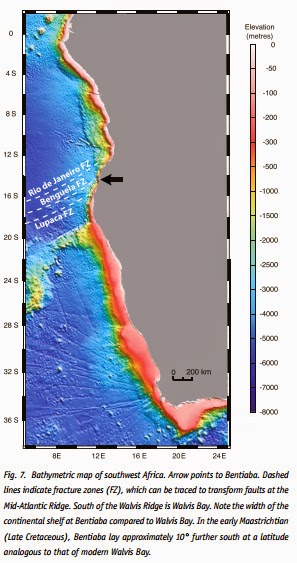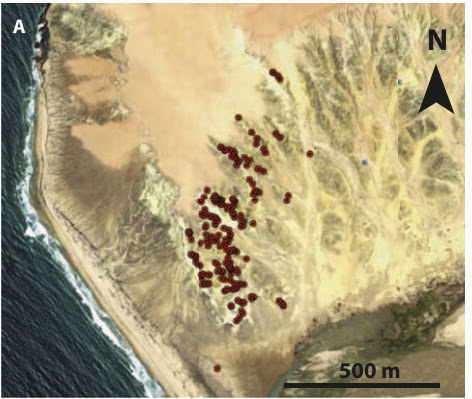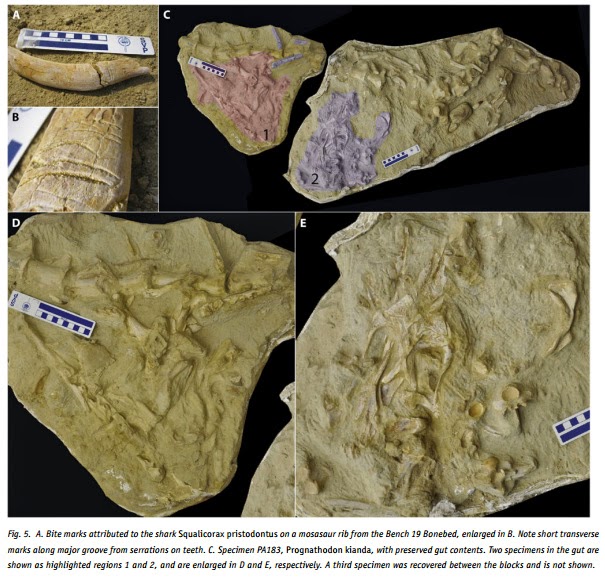A geologia e a riqueza faunística de Bentiaba em Angola sempre nos causou admiração. Um estudo do Projecto PaleoAngola, agora publicado, explica a geologia e paleoecologia da acumulação de ossos (bonebed) marinha
do Cretácico Superior na camada 19 de Bentiaba.
O estudo fez parte da dissertação de doutoramento de Chris Strganac sendo publicado agora no Netherlands Journal of Geosciences.
Geological setting and paleoecology of the Upper Cretaceous Bench 19 Marine Vertebrate Bonebed at Bentiaba, Angola
Abstract:
 The Bench 19 Bonebed at Bentiaba, Angola, is a unique concentration of marine vertebrates preserving six species of mosasaurs in sediments best correlated by magnetostratigraphy to chron C32n.1n between 71.4 and 71.64 Ma. The bonebed formed at a paleolatitude near 24°S, with an Atlantic width at that latitude approximating 2700 km, roughly half that of the current width. The locality lies on an uncharacteristically narrow continental shelf near transform faults that controlled the coastal outline of Africa in the formation of the South Atlantic Ocean. Biostratigraphic change through the Bentiaba section indicates that the accumulation occurred in an ecological time dimension within the 240 ky bin delimited by chron 32n.1n. The fauna occurs in a 10 m sand unit in the Mocuio Formation with bones and partial skeletons concentrated in, but not limited to, the basal 1–2 m. The sediment entombing the fossils is an immature feldspathic sand shown by detrital zircon ages to be derived from nearby granitic shield rocks. Specimens do not appear to have a strong preferred orientation and they are not concentrated in a strand line. Stable oxygen isotope analysis of associated bivalve shells indicates a water temperature of 18.5°C. The bonebed is clearly mixed with scattered dinosaur and pterosaur elements in a marine assemblage. Gut contents, scavenging marks and associated shed shark teeth in the Bench 19 Fauna indicate biological association and attrition due to feeding activities. The ecological diversity of mosasaur species is shown by tooth and body-size disparity and by d13C analysis of tooth enamel, which indicate a variety of foraging areas and dietary niches. The Bench 19 Fauna was formed in arid latitudes along a coastal desert similar to that of modern Namibia on a narrow, tectonically controlled continental shelf, in shallow waters below wave base. The area was used as a foraging ground for diverse species, including molluscivorus Globidens phosphaticus, small species expected near the coast, abundant Prognathodon kianda, which fed on other mosasaurs at Bench 19, and species that may have been transient and opportunistic feeders in the area.
The Bench 19 Bonebed at Bentiaba, Angola, is a unique concentration of marine vertebrates preserving six species of mosasaurs in sediments best correlated by magnetostratigraphy to chron C32n.1n between 71.4 and 71.64 Ma. The bonebed formed at a paleolatitude near 24°S, with an Atlantic width at that latitude approximating 2700 km, roughly half that of the current width. The locality lies on an uncharacteristically narrow continental shelf near transform faults that controlled the coastal outline of Africa in the formation of the South Atlantic Ocean. Biostratigraphic change through the Bentiaba section indicates that the accumulation occurred in an ecological time dimension within the 240 ky bin delimited by chron 32n.1n. The fauna occurs in a 10 m sand unit in the Mocuio Formation with bones and partial skeletons concentrated in, but not limited to, the basal 1–2 m. The sediment entombing the fossils is an immature feldspathic sand shown by detrital zircon ages to be derived from nearby granitic shield rocks. Specimens do not appear to have a strong preferred orientation and they are not concentrated in a strand line. Stable oxygen isotope analysis of associated bivalve shells indicates a water temperature of 18.5°C. The bonebed is clearly mixed with scattered dinosaur and pterosaur elements in a marine assemblage. Gut contents, scavenging marks and associated shed shark teeth in the Bench 19 Fauna indicate biological association and attrition due to feeding activities. The ecological diversity of mosasaur species is shown by tooth and body-size disparity and by d13C analysis of tooth enamel, which indicate a variety of foraging areas and dietary niches. The Bench 19 Fauna was formed in arid latitudes along a coastal desert similar to that of modern Namibia on a narrow, tectonically controlled continental shelf, in shallow waters below wave base. The area was used as a foraging ground for diverse species, including molluscivorus Globidens phosphaticus, small species expected near the coast, abundant Prognathodon kianda, which fed on other mosasaurs at Bench 19, and species that may have been transient and opportunistic feeders in the area.
Referência:
Strganac, C., Jacobs L., Polcyn M., Mateus O., Myers T., Araújo R., Fergunson K. M., Gonçalves A. O., Morais M. L., Schulp A. S., da Tavares T. S., & Salminen J. (2014). Geological Setting and Paleoecology of the Upper Cretaceous Bench 19 Marine Vertebrate Bonebed at Bentiaba, Angola. Netherlands Journal of Geosciences. 1-16.
PDF
O estudo fez parte da dissertação de doutoramento de Chris Strganac sendo publicado agora no Netherlands Journal of Geosciences.
 |
| Bentiaba com riqueza de achados |
Resumo:
 |
| Esqueleto de Prognathodon com conteúdos estomacais. |
A acumulação de ossos (bonebed) na camada 19 em Bentiaba,
Angola, é uma concentração única de vertebrados marinhos preservando seis
espécies de mosassauros em sedimentos correlacionadas por magneto-estratigrafia
ao Chron C32n.1n entre 71,4 e 71,64 Ma. A bonebed
formada numa paleolatitude perto de 24 ° S e com uma largura do Atlântico àquela
latitude de 2700 km, que é cerca de metade da largura da actual. A localidade
encontra-se numa plataforma continental estranhamente estreita perto das falhas
transformantes que controlavam o contorno do litoral da África na formação do
Oceano Atlântico Sul. Mudanças biostratigráficas através da seção de Bentiaba
indicam que a acumulação ocorreu numa faixa de tempo de 240.000 de anos dentro
da chron 32n.1n. A fauna ocorre numa unidade de 10 m areia na Formação Mocuio
com ossos e esqueletos incompletos concentrados aos 1-2 m mais basais, mas não
limitados a estes. O sedimento que cobre os fósseis é uma areia feldspática imatura
demonstrado por zircões detríticos derivados das rochas graníticas. As amostras
não parecem ter uma forte orientação preferencial e não é concentrada numa
linha de costa. Análise de isótopos estáveis de oxigénio de conchas de bivalves
associados indica uma temperatura de água de 18,5 ° C. A bonebed é claramente misturada com elementos de dinossauros e
pterossauros dispersos num cortejo de fauna marinha. A associação de conteúdos
estomacais e marcas de dentes de tubarão na Camada 19 indicam associação
biológica devido às atividades de alimentação. A diversidade ecológica de
espécies de mosassauros é mostrada pela disparidade de dente e tamanho do corpo
e pela análise d13C do esmalte dos dentes, o que indica uma variedade de áreas
de alimentação e nichos alimentares. A fauna da camada 19 viveu em latitudes
áridas ao longo de um deserto costeiro semelhante ao da Namíbia moderna, numa
plataforma continental estreita e tectonicamente controlada, em águas rasas
abaixo base de ondas. A área foi usada como uma área de alimentação para
diversas espécies, incluindo Globidens
phosphaticus, pequenas espécies costeiras, abundante Prognathodon kianda, que alimentava de outros mosassauros na camada
19, e espécies que podem ter sido alimentadores oportunistas na área.
Geological setting and paleoecology of the Upper Cretaceous Bench 19 Marine Vertebrate Bonebed at Bentiaba, Angola
Abstract:
 The Bench 19 Bonebed at Bentiaba, Angola, is a unique concentration of marine vertebrates preserving six species of mosasaurs in sediments best correlated by magnetostratigraphy to chron C32n.1n between 71.4 and 71.64 Ma. The bonebed formed at a paleolatitude near 24°S, with an Atlantic width at that latitude approximating 2700 km, roughly half that of the current width. The locality lies on an uncharacteristically narrow continental shelf near transform faults that controlled the coastal outline of Africa in the formation of the South Atlantic Ocean. Biostratigraphic change through the Bentiaba section indicates that the accumulation occurred in an ecological time dimension within the 240 ky bin delimited by chron 32n.1n. The fauna occurs in a 10 m sand unit in the Mocuio Formation with bones and partial skeletons concentrated in, but not limited to, the basal 1–2 m. The sediment entombing the fossils is an immature feldspathic sand shown by detrital zircon ages to be derived from nearby granitic shield rocks. Specimens do not appear to have a strong preferred orientation and they are not concentrated in a strand line. Stable oxygen isotope analysis of associated bivalve shells indicates a water temperature of 18.5°C. The bonebed is clearly mixed with scattered dinosaur and pterosaur elements in a marine assemblage. Gut contents, scavenging marks and associated shed shark teeth in the Bench 19 Fauna indicate biological association and attrition due to feeding activities. The ecological diversity of mosasaur species is shown by tooth and body-size disparity and by d13C analysis of tooth enamel, which indicate a variety of foraging areas and dietary niches. The Bench 19 Fauna was formed in arid latitudes along a coastal desert similar to that of modern Namibia on a narrow, tectonically controlled continental shelf, in shallow waters below wave base. The area was used as a foraging ground for diverse species, including molluscivorus Globidens phosphaticus, small species expected near the coast, abundant Prognathodon kianda, which fed on other mosasaurs at Bench 19, and species that may have been transient and opportunistic feeders in the area.
The Bench 19 Bonebed at Bentiaba, Angola, is a unique concentration of marine vertebrates preserving six species of mosasaurs in sediments best correlated by magnetostratigraphy to chron C32n.1n between 71.4 and 71.64 Ma. The bonebed formed at a paleolatitude near 24°S, with an Atlantic width at that latitude approximating 2700 km, roughly half that of the current width. The locality lies on an uncharacteristically narrow continental shelf near transform faults that controlled the coastal outline of Africa in the formation of the South Atlantic Ocean. Biostratigraphic change through the Bentiaba section indicates that the accumulation occurred in an ecological time dimension within the 240 ky bin delimited by chron 32n.1n. The fauna occurs in a 10 m sand unit in the Mocuio Formation with bones and partial skeletons concentrated in, but not limited to, the basal 1–2 m. The sediment entombing the fossils is an immature feldspathic sand shown by detrital zircon ages to be derived from nearby granitic shield rocks. Specimens do not appear to have a strong preferred orientation and they are not concentrated in a strand line. Stable oxygen isotope analysis of associated bivalve shells indicates a water temperature of 18.5°C. The bonebed is clearly mixed with scattered dinosaur and pterosaur elements in a marine assemblage. Gut contents, scavenging marks and associated shed shark teeth in the Bench 19 Fauna indicate biological association and attrition due to feeding activities. The ecological diversity of mosasaur species is shown by tooth and body-size disparity and by d13C analysis of tooth enamel, which indicate a variety of foraging areas and dietary niches. The Bench 19 Fauna was formed in arid latitudes along a coastal desert similar to that of modern Namibia on a narrow, tectonically controlled continental shelf, in shallow waters below wave base. The area was used as a foraging ground for diverse species, including molluscivorus Globidens phosphaticus, small species expected near the coast, abundant Prognathodon kianda, which fed on other mosasaurs at Bench 19, and species that may have been transient and opportunistic feeders in the area.Referência:
Strganac, C., Jacobs L., Polcyn M., Mateus O., Myers T., Araújo R., Fergunson K. M., Gonçalves A. O., Morais M. L., Schulp A. S., da Tavares T. S., & Salminen J. (2014). Geological Setting and Paleoecology of the Upper Cretaceous Bench 19 Marine Vertebrate Bonebed at Bentiaba, Angola. Netherlands Journal of Geosciences. 1-16.




Sem comentários:
Enviar um comentário